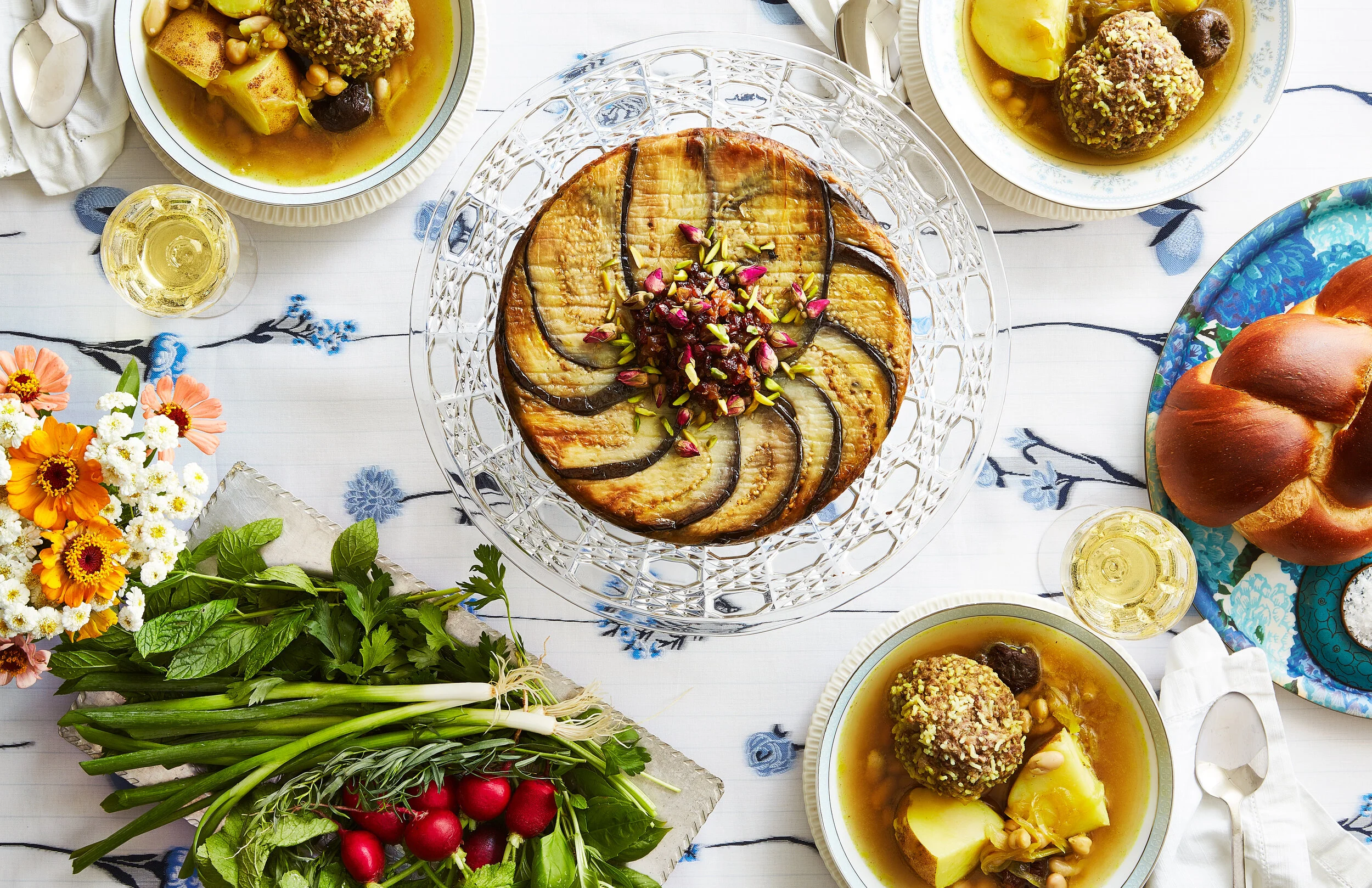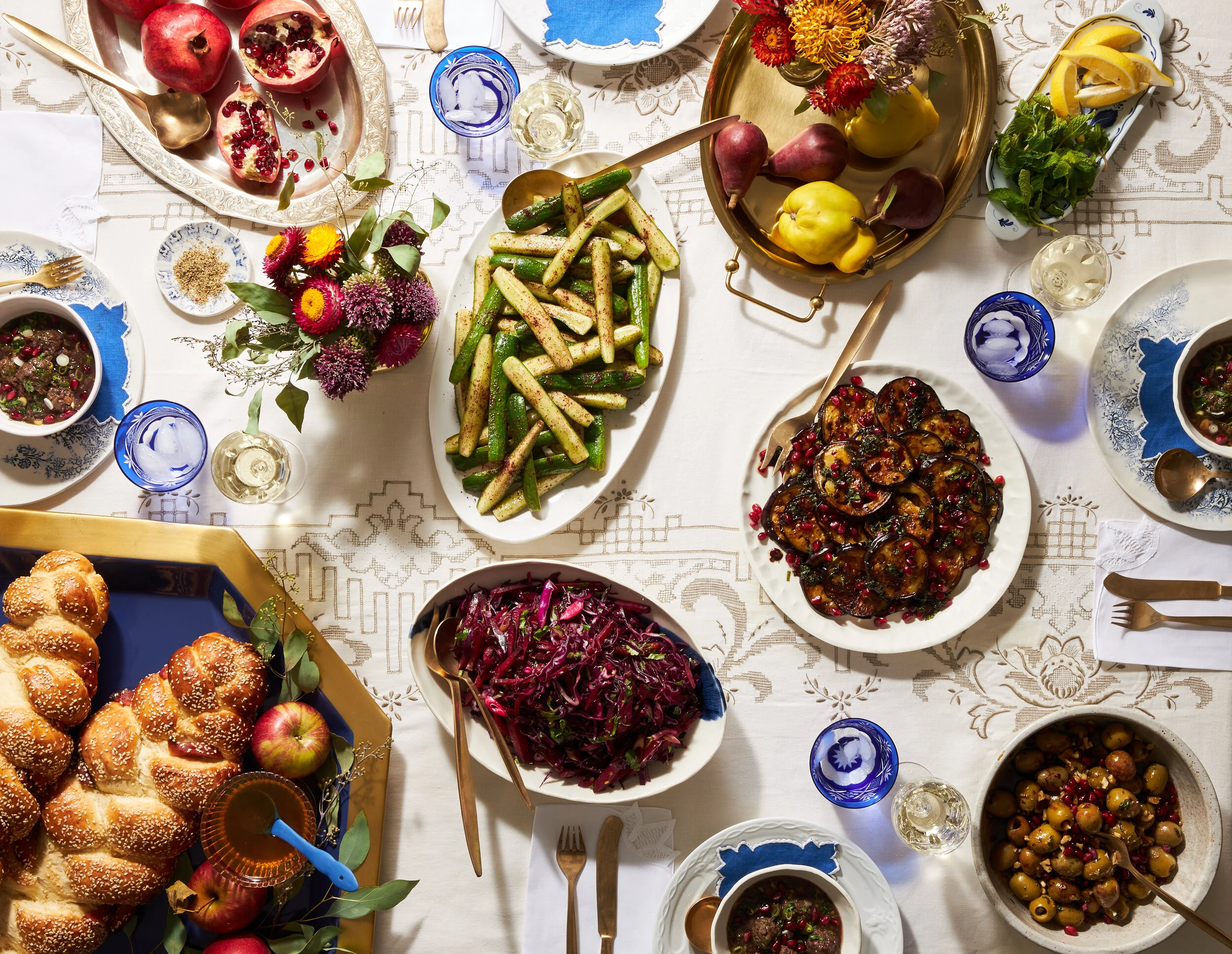The Persian Winter Shabbat Recipes Cooked Under a Grandmother’s Blanket
Photography by Armando Rafael, Food Styling by Rebecca Jurkevich, Prop Styling by Vanessa Vazquez.
Shared by Ayelet Latovitch
Recipe Roots: Mashhad, Iran > Hadera, Israel > Tel Aviv
The door to Rachel Hoshmand’s home at the southern edge of Tel Aviv was always revolving on Shabbat. Ayelet Latovitch, her granddaughter and the culinary director of Asif, remembers her nine cousins, aunts, uncles, and parents, flowing in and out. In the warmer months, Ayelet would arrive for a late Saturday breakfast, then head for the beach or a hike, and return before the end of the day for another meal. When it was raining, she and her cousins would pass the entire day at their grandparents’ home, clearing furniture in the living room to play or piling onto the couch to watch tv or a movie. The rhythm of Shabbat was marked by Rachel’s cooking.
On those cold winter mornings, Rachel would wake up early to check on dishes left to cook overnight on a plata or blech, a large hot plate common in religious Jewish homes. Pulling back a blanket that she used to insulate the pots, she would make sure there was enough water in her halim, a Persian porridge of wheat berries, chickpeas, and arborio rice flavored with marrow bones that she served for a late breakfast. “As kids, this was our treat,” Ayelet adds. She and her cousins would top their dish with sugar, cinnamon, and lemon when they were young — and in later years, the family started to serve it with the Yemenite hot sauce schug.
Ayelet’s grandmother Rachel (Khorshid) with cousin Ravit and Ayelet’s daughter, Arielle in 2002.
Under the blanket there might also be a pot of polo shabati, or rice enriched with chicken thighs and calf tongue, perfumed with cinnamon and sweetened with dried fruits, that she served for Seudah Shlishit, or the final meal of Shabbat. Ayelet believes the dish is unique to the Jewish community of her grandmother’s hometown of Mashhad in northeastern Iran, near the border with Turkmenistan.
*
In Mashhad, Rachel was married “quite young, and very fast, and not to the person she chose necessarily,” Ayelet explains. This was a time, she adds, when marriage served as a protection for young Jewish women living in a largely Muslim society. She had four children there and in the early 1950s, the family moved to Israel where Ayelet’s mother was born.
Rachel was modern and forward thinking, a feminist in a community where that model for a woman of her generation wasn’t common, says Ayelet. She changed her name from Khorsheid to Rachel and insisted on speaking Hebrew at home. She worked at first in agriculture, later in a drape factory, and when she injured her back, Rachel started her own business arranging tours for Persian Jews visiting Israel, often looking for a bride or groom for their children.
“She liked the good life,” Ayelet explains, a life she was in control of. Perhaps because of her career and how hard she worked, Ayelet adds, her cooking repertoire was narrow, but delicious, focused on the dishes most beloved by family members. She used cooking as a way to stay at the center of family life.
Her recipes and the Saturday gatherings left their mark on the family. Rachel passed away 15 years ago, but the cousins continue to gather today for meals on Fridays when they can and take an annual trip around Rosh Hashanah to a beach in Eilat that Rachel loved. When Ayelet makes her recipes, she says, “I feel my roots, I feel grounded.”
Halim (Persian Porridge)
As a child, Ayelet knew this dish as ash, she explains. She later learned that ash is a category of dishes and this specific one is referred to as halim. “In most [Persian Jewish] homes, halim is an overnight Shabbat cholent that's served in the morning and contains meat,” she adds. Her grandmother made hers with marrow bones instead and cooked it slowly atop a large hot plate. Ayelet’s rendition trades the hot plate for an oven that’s kept at a low temperature.
Makes: 6-8 servings
Total Time: Overnight soaking + 10 minutes active + Inactive overnight cooking
Ingredients
1 cup arborio rice or any other short grain rice
1 cup wheat berries
1 cup dried chickpeas
3-5 beef marrow bones, cut into 2 inch pieces crosswise
1 tablespoons plus ½ teaspoon Kosher salt
1 ½ teaspoons ground black pepper
For garnish:
Granulated sugar
Ground cinnamon
Preparation:
1. Place the rice, wheat berries, and chickpeas into a large bowl. Completely cover with room temperature water and soak overnight or for at least 8 hours.
2. Drain the rice, wheat berries and chickpeas and rinse with water. Place the rice, wheatberries and chickpeas into a 4 quart Dutch oven or stainless steel pot.
3. Preheat the oven to 230° F.
4. Add the beef marrow bones into a separate pot and cover completely with water. Bring to a boil over high heat and boil the marrow bones for 5 minutes. Drain the bones and rinse them with water.
5. Add the marrow bones into the pot with the rice, wheat berries and chickpeas. Add the salt and pepper and 10 ½ cups of water into the pot and give the mixture a stir. Bring the mixture to a boil over high heat, skimming any foam that rises to the top. Place a lid on the pot and transfer it into the oven. Cook overnight or for at least 8 hours.
6. Transfer the pot out of the oven. The halim should be a porridge-like consistency. If the mixture is too liquidy you can increase the heat of the oven to 285° F, place the halim back into the oven uncovered and cook for one more hour or until it thickens into a porridge-like consistency.
7. Serve the halim hot. Ayelet sprinkles a bit of sugar and cinnamon on top.
Chef’s Note: Ayelet recommends checking the halim after it's been cooking in the oven for 6 hours. Transfer the pot from the oven and use a wooden spoon to mix the halim, making sure to scrape the bottom of the pot. This is also a good time to taste the halim and adjust the seasoning if needed. Place the covered pot back into the oven.
Polo Shabati (Persian Shabbat Rice with Beef and Dried Fruit)
This recipe is “my favorite Shabbat dish of all time,” proclaims Ayelet. It’s an uncommon recipe and to ensure her rendition matched her grandmother’s, she cross referenced it with the one prepared by her aunts. Like the halim recipe, her grandmother prepared the polo shabati on a large hot plate, leaving it to cook overnight. This version is made in an oven at a low temperature.
Makes: 8-10 servings
Total Time: 2 ½ hours + Overnight inactive cooking
Ingredients
1 whole beef tongue or 3 pounds beef chuck meat, cut into 1-2 inch pieces
¾ cups plus 2 teaspoons Kosher salt, divided
½ teaspoon ground black pepper
4 bone-in skin-on chicken quarters
4 cups basmati rice, soaked in water for 30 minutes, then drained and rinsed
1 ½ cups canola oil, plus more
1-2 russet potatoes, peeled and cut crosswise into ¼ inch pieces
2-3 quinces or beets whole, peeled
1-2 teaspoons ground cinnamon
1 cup pitted dried dates
1 cup pitted prunes
½ cup golden raisins
½ cup dried cherries
Preparation
1. Place the whole tongue or chuck meat into a large pot and cover completely with water. Generously season the water with 2 teaspoons of salt and 1 teaspoon of ground pepper. Bring the pot to a boil over high heat and then reduce the heat to medium/low- low heat. Cover with a lid and cook the meat on a gentle simmer for 1 hour and 50 minutes or until the tongue is completely cooked through and tender. Add the chicken quarters and cook them in the pot with the beef for 10 minutes on a simmer (increasing the heat if needed). Drain the beef and chicken and rinse with water. Set the chuck meat chicken aside.
2. If using the beef tongue, use a paring knife to peel the outer membrane layer of the tongue. Cut a slit down the center of the tongue lengthwise and pull the skin back until the tongue is peeled. Discard the outer layer and set the tongue aside.
3. Fill up a large pot with water halfway up the pot. Add 1 tablespoon of salt and set the pot over high heat. Bring the water to a boil. Add the rice and cook the rice for 6 minutes or until it is par cooked. Drain and rinse the rice. Place the par-cooked rice into a mixing bowl and add ¼ cup canola oil. Mix the rice with the oil until the grains of rice are coated evenly with oil.
4. Preheat the oven to 320° F.
5. Pour canola oil into a large dutch oven (about 8 quarts) to form a ¼ inch layer of oil in the bottom of the pot. Place the potato slices down into the pot in one layer side by side (not overlapping) covering the whole bottom of the pot. Sprinkle the potatoes with 1 teaspoon of salt. Place the pot over high heat on the stove and fry the potatoes for 8 minutes (this step helps the potatoes get color and prevents the potatoes from sticking to the bottom of the pot. Transfer the pot off the heat.
6. Place the quince or beets, chicken quarters and tongue or chuck meat into a large mixing bowl. Sprinkle the mixture with 2 tablespoons of salt and 1-2 tablespoons of cinnamon. Use your hands to rub the cinnamon and salt over the quince or beets, chicken and meat,, making sure to cover all the surfaces. Set aside.
7. Assemble the polo Shabbati: Sprinkle half of the par cooked rice on top of the potatoes in the Dutch oven in an even layer. Place the quince or beets on top of the rice layer evenly, place the tongue or chuck meat on top of the quince or beets. Place the chicken quarters on top or to the side of the meat and cover the pot with the remaining half of the rice. The rice should completely cover the chicken meat in the pot. Sprinkle the rice with 2 teaspoons of salt. Pour 1 cup of water and 1 cup of oil evenly all over the components in the pot.
8. Place the dried fruit including the dates, prunes, raisins and cherries onto the center of a large piece of parchment paper. Bring both edges of the parchment paper together and fold them over each other in a crimping pattern to seal the dried fruit in this pouch of parchment paper. Place the pouch of dried fruit over the rice and cover the pot with a lid.
9. Place the pot into the oven and bake for 40 minutes. Reduce the oven temperature to 212° F and continue to cook in the oven overnight or for at least 8 hours.
10. To serve: Transfer the Dutch oven from the oven. Take out the parchment paper pouch with the dried fruit and set aside. Take the chicken pieces, beef, and quince or beets out of the pot. Mix the rice that's left in the pot with all the fat and juices in the pot. Place this rice into a serving platter. Scrape the potatoes off of the bottom of the pot and put the potatoes on the rice. Put the chicken pieces and tongue or chuck meat over the rice. You can tear the meat and chicken apart into smaller pieces if desired. Place the quince or beets onto the rice platter and serve immediately.












